Analysis of System Thinking and System Engineering for Project Success
VerifiedAdded on 2023/01/20
|14
|3274
|35
Report
AI Summary
This report delves into the multifaceted concepts of system thinking and system engineering, exploring their crucial roles in project management and organizational success. It begins by defining system engineering and its application in managing complex systems throughout the project lifecycle, emphasizing the importance of factors like requirements engineering, risk management, and optimization. The report then examines the general management system, organizational structures, and the significance of effective communication, drawing on the Deepwater Horizon case to illustrate the consequences of communication breakdowns. Furthermore, it explores the application of system engineering in risk management, portfolio alignment, and business value creation. It also discusses the portfolio management process cycle and organizational maturity, providing a comprehensive overview of how these elements contribute to successful project outcomes and organizational growth. The report concludes by summarizing the key insights and emphasizing the importance of integrating system thinking and engineering principles for achieving project goals and enhancing business value.
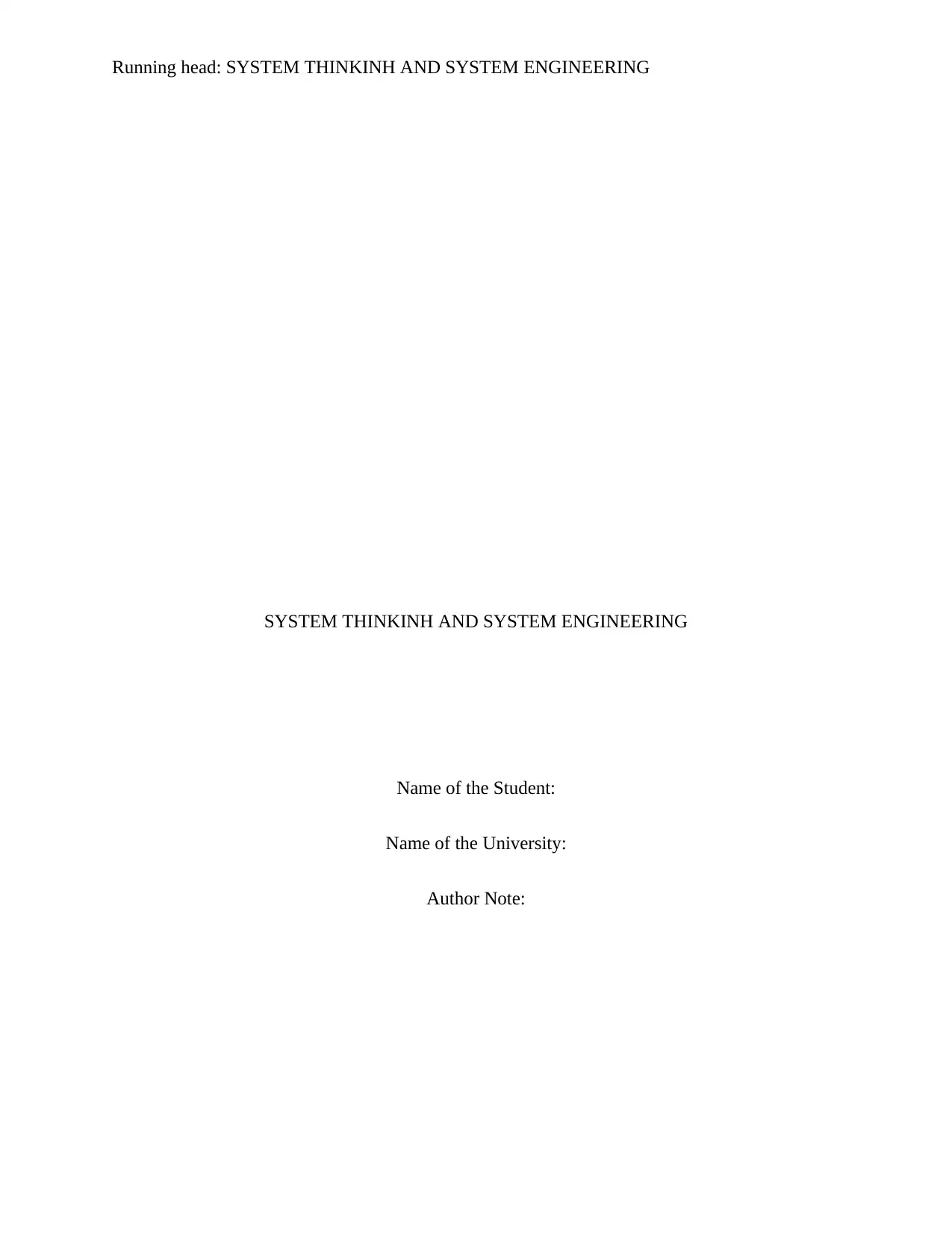
Running head: SYSTEM THINKINH AND SYSTEM ENGINEERING
SYSTEM THINKINH AND SYSTEM ENGINEERING
Name of the Student:
Name of the University:
Author Note:
SYSTEM THINKINH AND SYSTEM ENGINEERING
Name of the Student:
Name of the University:
Author Note:
Paraphrase This Document
Need a fresh take? Get an instant paraphrase of this document with our AI Paraphraser
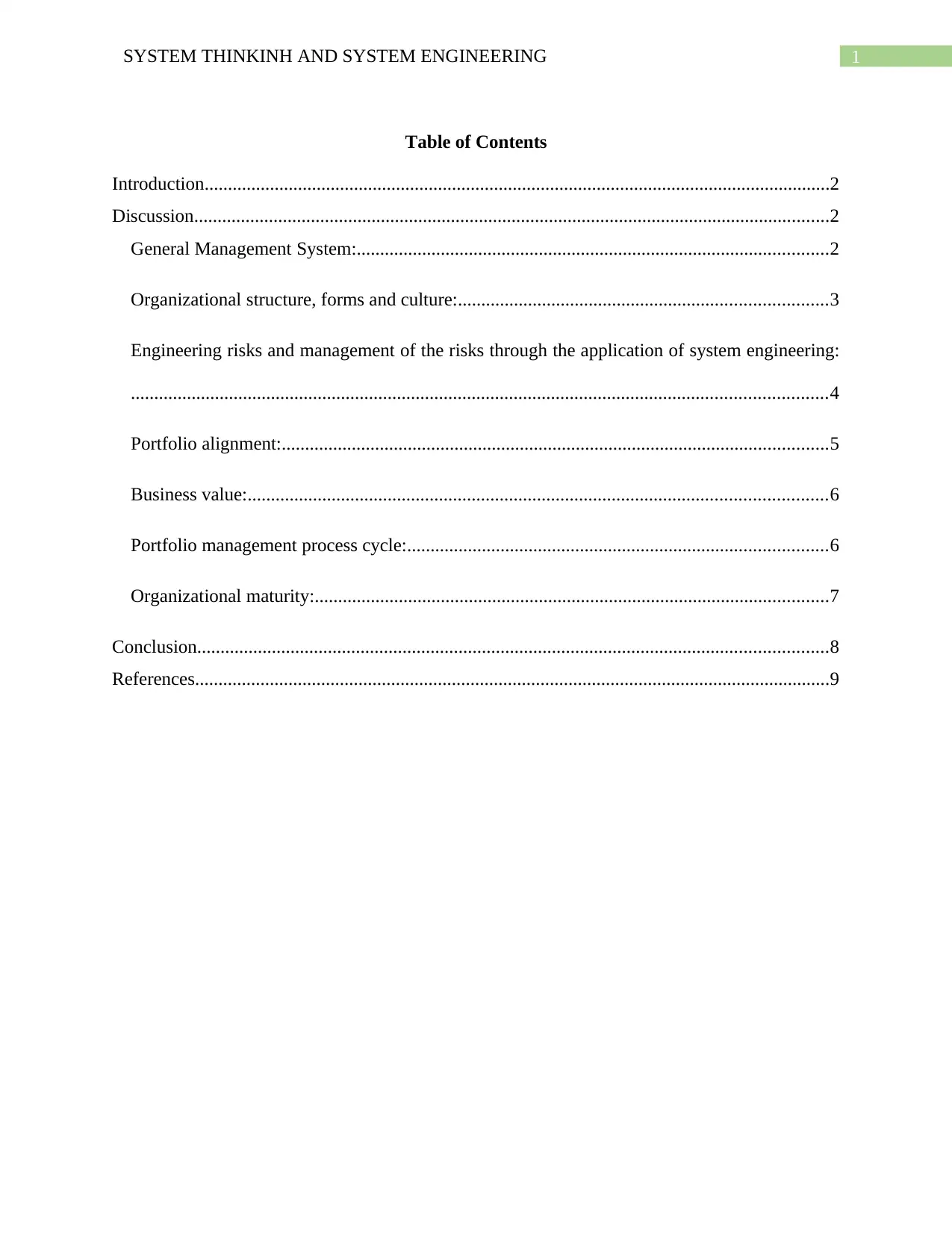
1SYSTEM THINKINH AND SYSTEM ENGINEERING
Table of Contents
Introduction......................................................................................................................................2
Discussion........................................................................................................................................2
General Management System:.....................................................................................................2
Organizational structure, forms and culture:...............................................................................3
Engineering risks and management of the risks through the application of system engineering:
.....................................................................................................................................................4
Portfolio alignment:.....................................................................................................................5
Business value:............................................................................................................................6
Portfolio management process cycle:..........................................................................................6
Organizational maturity:..............................................................................................................7
Conclusion.......................................................................................................................................8
References........................................................................................................................................9
Table of Contents
Introduction......................................................................................................................................2
Discussion........................................................................................................................................2
General Management System:.....................................................................................................2
Organizational structure, forms and culture:...............................................................................3
Engineering risks and management of the risks through the application of system engineering:
.....................................................................................................................................................4
Portfolio alignment:.....................................................................................................................5
Business value:............................................................................................................................6
Portfolio management process cycle:..........................................................................................6
Organizational maturity:..............................................................................................................7
Conclusion.......................................................................................................................................8
References........................................................................................................................................9
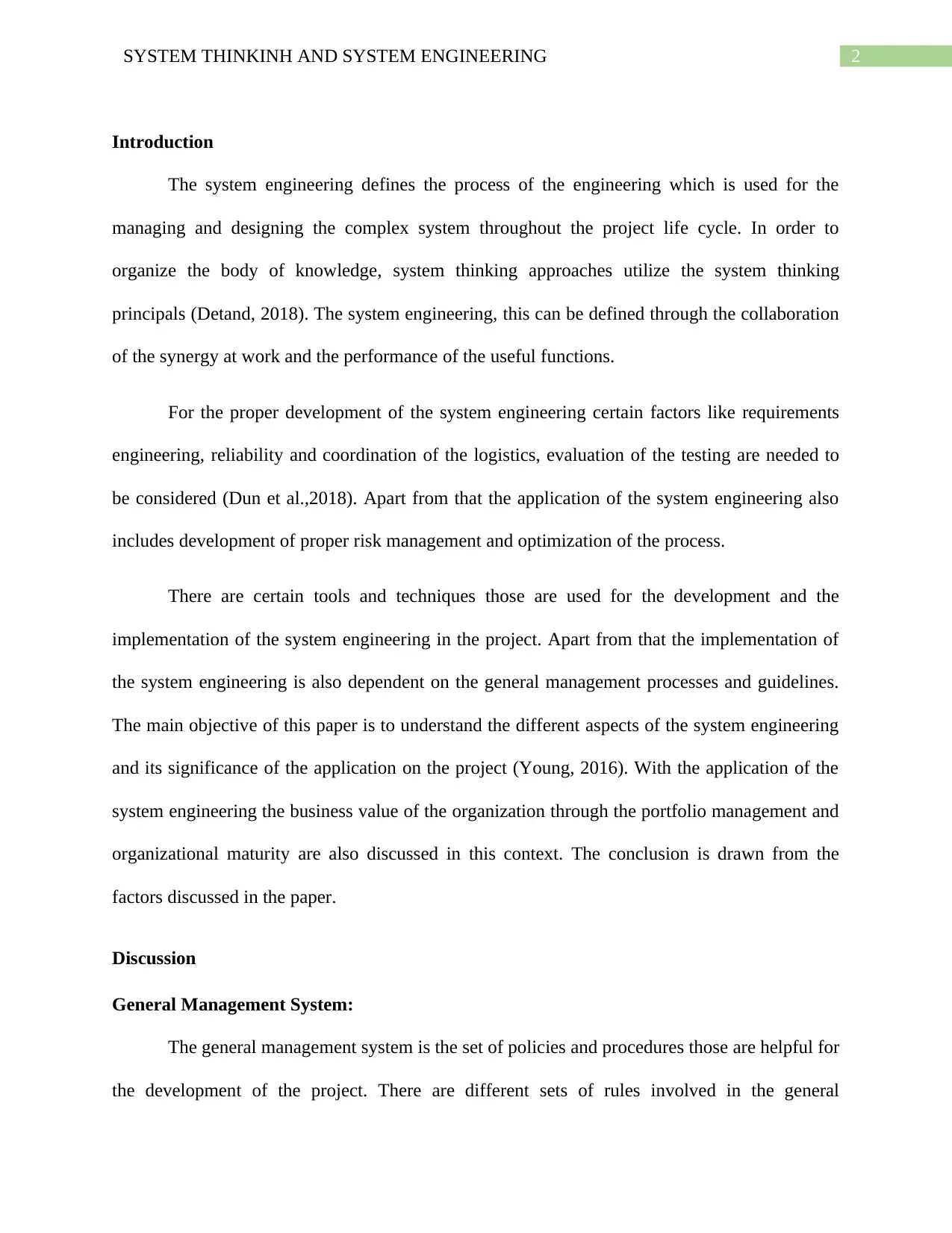
2SYSTEM THINKINH AND SYSTEM ENGINEERING
Introduction
The system engineering defines the process of the engineering which is used for the
managing and designing the complex system throughout the project life cycle. In order to
organize the body of knowledge, system thinking approaches utilize the system thinking
principals (Detand, 2018). The system engineering, this can be defined through the collaboration
of the synergy at work and the performance of the useful functions.
For the proper development of the system engineering certain factors like requirements
engineering, reliability and coordination of the logistics, evaluation of the testing are needed to
be considered (Dun et al.,2018). Apart from that the application of the system engineering also
includes development of proper risk management and optimization of the process.
There are certain tools and techniques those are used for the development and the
implementation of the system engineering in the project. Apart from that the implementation of
the system engineering is also dependent on the general management processes and guidelines.
The main objective of this paper is to understand the different aspects of the system engineering
and its significance of the application on the project (Young, 2016). With the application of the
system engineering the business value of the organization through the portfolio management and
organizational maturity are also discussed in this context. The conclusion is drawn from the
factors discussed in the paper.
Discussion
General Management System:
The general management system is the set of policies and procedures those are helpful for
the development of the project. There are different sets of rules involved in the general
Introduction
The system engineering defines the process of the engineering which is used for the
managing and designing the complex system throughout the project life cycle. In order to
organize the body of knowledge, system thinking approaches utilize the system thinking
principals (Detand, 2018). The system engineering, this can be defined through the collaboration
of the synergy at work and the performance of the useful functions.
For the proper development of the system engineering certain factors like requirements
engineering, reliability and coordination of the logistics, evaluation of the testing are needed to
be considered (Dun et al.,2018). Apart from that the application of the system engineering also
includes development of proper risk management and optimization of the process.
There are certain tools and techniques those are used for the development and the
implementation of the system engineering in the project. Apart from that the implementation of
the system engineering is also dependent on the general management processes and guidelines.
The main objective of this paper is to understand the different aspects of the system engineering
and its significance of the application on the project (Young, 2016). With the application of the
system engineering the business value of the organization through the portfolio management and
organizational maturity are also discussed in this context. The conclusion is drawn from the
factors discussed in the paper.
Discussion
General Management System:
The general management system is the set of policies and procedures those are helpful for
the development of the project. There are different sets of rules involved in the general
⊘ This is a preview!⊘
Do you want full access?
Subscribe today to unlock all pages.

Trusted by 1+ million students worldwide
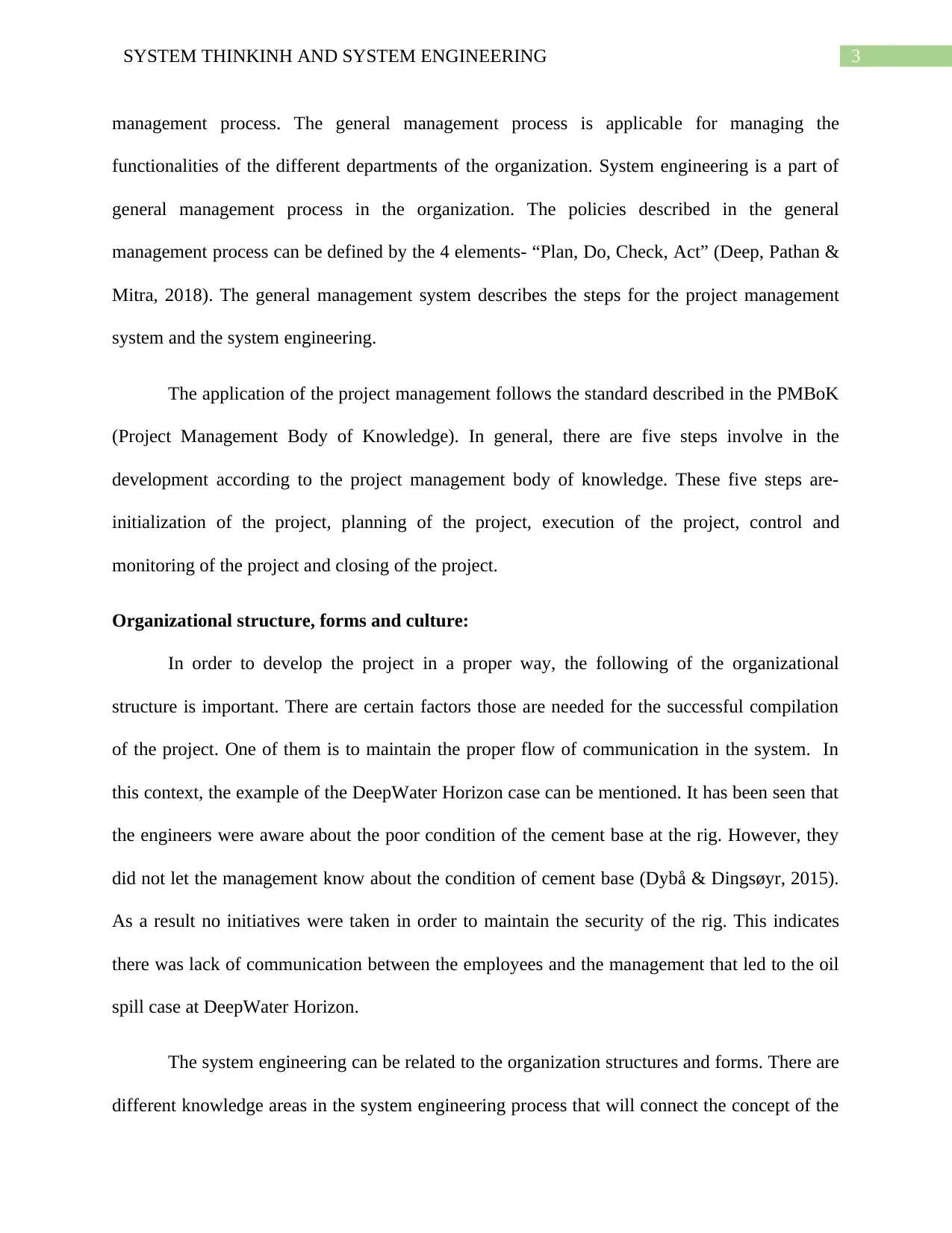
3SYSTEM THINKINH AND SYSTEM ENGINEERING
management process. The general management process is applicable for managing the
functionalities of the different departments of the organization. System engineering is a part of
general management process in the organization. The policies described in the general
management process can be defined by the 4 elements- “Plan, Do, Check, Act” (Deep, Pathan &
Mitra, 2018). The general management system describes the steps for the project management
system and the system engineering.
The application of the project management follows the standard described in the PMBoK
(Project Management Body of Knowledge). In general, there are five steps involve in the
development according to the project management body of knowledge. These five steps are-
initialization of the project, planning of the project, execution of the project, control and
monitoring of the project and closing of the project.
Organizational structure, forms and culture:
In order to develop the project in a proper way, the following of the organizational
structure is important. There are certain factors those are needed for the successful compilation
of the project. One of them is to maintain the proper flow of communication in the system. In
this context, the example of the DeepWater Horizon case can be mentioned. It has been seen that
the engineers were aware about the poor condition of the cement base at the rig. However, they
did not let the management know about the condition of cement base (Dybå & Dingsøyr, 2015).
As a result no initiatives were taken in order to maintain the security of the rig. This indicates
there was lack of communication between the employees and the management that led to the oil
spill case at DeepWater Horizon.
The system engineering can be related to the organization structures and forms. There are
different knowledge areas in the system engineering process that will connect the concept of the
management process. The general management process is applicable for managing the
functionalities of the different departments of the organization. System engineering is a part of
general management process in the organization. The policies described in the general
management process can be defined by the 4 elements- “Plan, Do, Check, Act” (Deep, Pathan &
Mitra, 2018). The general management system describes the steps for the project management
system and the system engineering.
The application of the project management follows the standard described in the PMBoK
(Project Management Body of Knowledge). In general, there are five steps involve in the
development according to the project management body of knowledge. These five steps are-
initialization of the project, planning of the project, execution of the project, control and
monitoring of the project and closing of the project.
Organizational structure, forms and culture:
In order to develop the project in a proper way, the following of the organizational
structure is important. There are certain factors those are needed for the successful compilation
of the project. One of them is to maintain the proper flow of communication in the system. In
this context, the example of the DeepWater Horizon case can be mentioned. It has been seen that
the engineers were aware about the poor condition of the cement base at the rig. However, they
did not let the management know about the condition of cement base (Dybå & Dingsøyr, 2015).
As a result no initiatives were taken in order to maintain the security of the rig. This indicates
there was lack of communication between the employees and the management that led to the oil
spill case at DeepWater Horizon.
The system engineering can be related to the organization structures and forms. There are
different knowledge areas in the system engineering process that will connect the concept of the
Paraphrase This Document
Need a fresh take? Get an instant paraphrase of this document with our AI Paraphraser
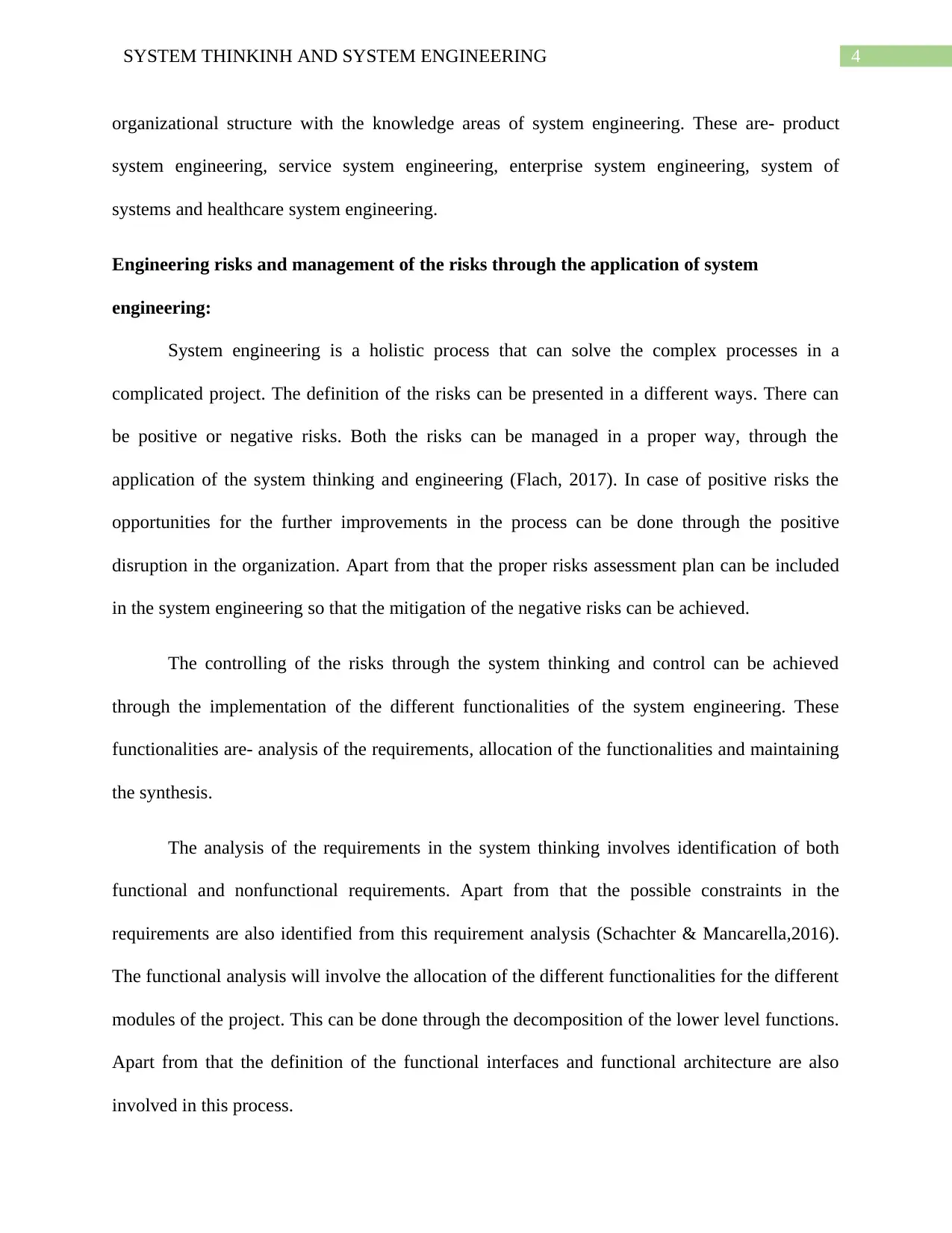
4SYSTEM THINKINH AND SYSTEM ENGINEERING
organizational structure with the knowledge areas of system engineering. These are- product
system engineering, service system engineering, enterprise system engineering, system of
systems and healthcare system engineering.
Engineering risks and management of the risks through the application of system
engineering:
System engineering is a holistic process that can solve the complex processes in a
complicated project. The definition of the risks can be presented in a different ways. There can
be positive or negative risks. Both the risks can be managed in a proper way, through the
application of the system thinking and engineering (Flach, 2017). In case of positive risks the
opportunities for the further improvements in the process can be done through the positive
disruption in the organization. Apart from that the proper risks assessment plan can be included
in the system engineering so that the mitigation of the negative risks can be achieved.
The controlling of the risks through the system thinking and control can be achieved
through the implementation of the different functionalities of the system engineering. These
functionalities are- analysis of the requirements, allocation of the functionalities and maintaining
the synthesis.
The analysis of the requirements in the system thinking involves identification of both
functional and nonfunctional requirements. Apart from that the possible constraints in the
requirements are also identified from this requirement analysis (Schachter & Mancarella,2016).
The functional analysis will involve the allocation of the different functionalities for the different
modules of the project. This can be done through the decomposition of the lower level functions.
Apart from that the definition of the functional interfaces and functional architecture are also
involved in this process.
organizational structure with the knowledge areas of system engineering. These are- product
system engineering, service system engineering, enterprise system engineering, system of
systems and healthcare system engineering.
Engineering risks and management of the risks through the application of system
engineering:
System engineering is a holistic process that can solve the complex processes in a
complicated project. The definition of the risks can be presented in a different ways. There can
be positive or negative risks. Both the risks can be managed in a proper way, through the
application of the system thinking and engineering (Flach, 2017). In case of positive risks the
opportunities for the further improvements in the process can be done through the positive
disruption in the organization. Apart from that the proper risks assessment plan can be included
in the system engineering so that the mitigation of the negative risks can be achieved.
The controlling of the risks through the system thinking and control can be achieved
through the implementation of the different functionalities of the system engineering. These
functionalities are- analysis of the requirements, allocation of the functionalities and maintaining
the synthesis.
The analysis of the requirements in the system thinking involves identification of both
functional and nonfunctional requirements. Apart from that the possible constraints in the
requirements are also identified from this requirement analysis (Schachter & Mancarella,2016).
The functional analysis will involve the allocation of the different functionalities for the different
modules of the project. This can be done through the decomposition of the lower level functions.
Apart from that the definition of the functional interfaces and functional architecture are also
involved in this process.
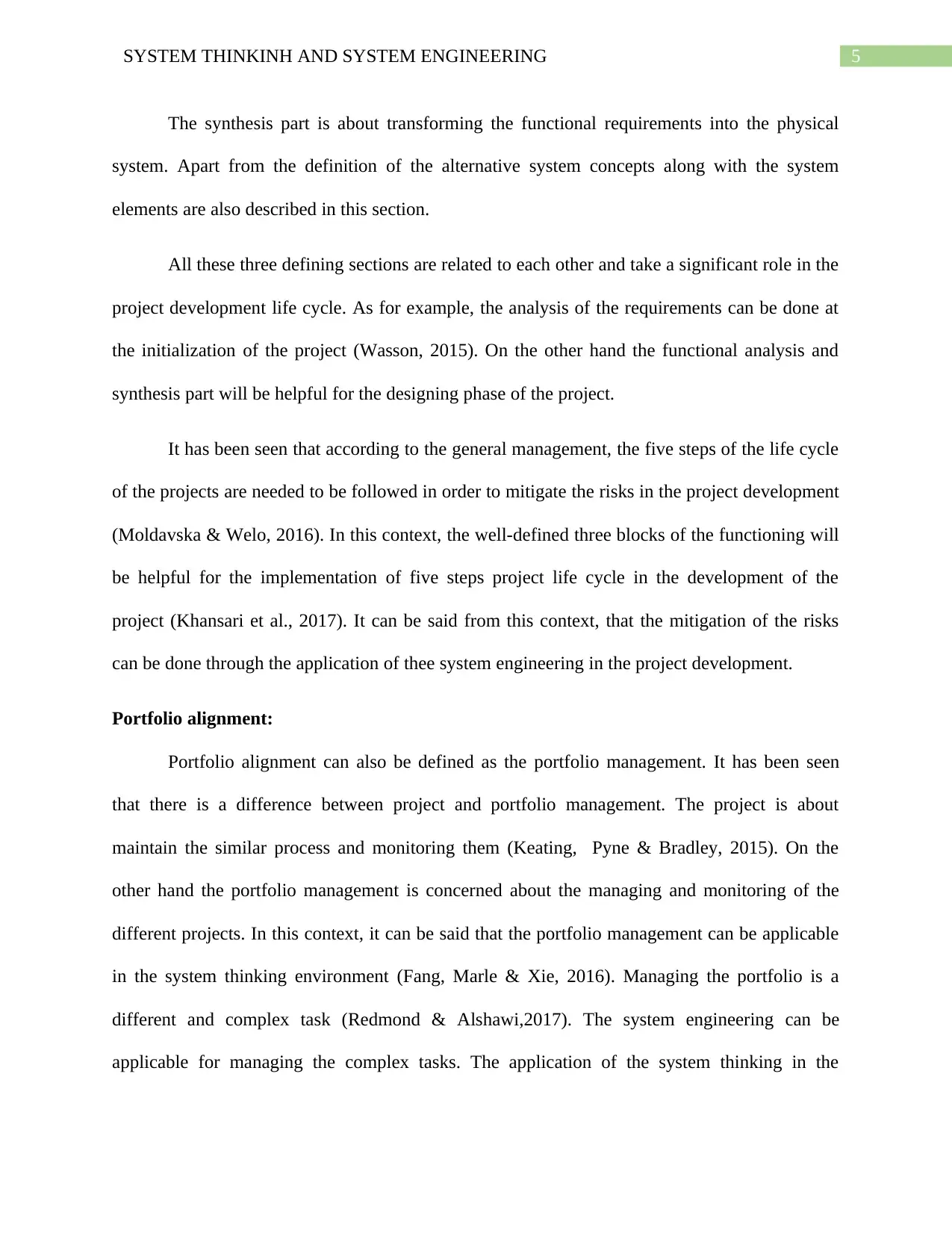
5SYSTEM THINKINH AND SYSTEM ENGINEERING
The synthesis part is about transforming the functional requirements into the physical
system. Apart from the definition of the alternative system concepts along with the system
elements are also described in this section.
All these three defining sections are related to each other and take a significant role in the
project development life cycle. As for example, the analysis of the requirements can be done at
the initialization of the project (Wasson, 2015). On the other hand the functional analysis and
synthesis part will be helpful for the designing phase of the project.
It has been seen that according to the general management, the five steps of the life cycle
of the projects are needed to be followed in order to mitigate the risks in the project development
(Moldavska & Welo, 2016). In this context, the well-defined three blocks of the functioning will
be helpful for the implementation of five steps project life cycle in the development of the
project (Khansari et al., 2017). It can be said from this context, that the mitigation of the risks
can be done through the application of thee system engineering in the project development.
Portfolio alignment:
Portfolio alignment can also be defined as the portfolio management. It has been seen
that there is a difference between project and portfolio management. The project is about
maintain the similar process and monitoring them (Keating, Pyne & Bradley, 2015). On the
other hand the portfolio management is concerned about the managing and monitoring of the
different projects. In this context, it can be said that the portfolio management can be applicable
in the system thinking environment (Fang, Marle & Xie, 2016). Managing the portfolio is a
different and complex task (Redmond & Alshawi,2017). The system engineering can be
applicable for managing the complex tasks. The application of the system thinking in the
The synthesis part is about transforming the functional requirements into the physical
system. Apart from the definition of the alternative system concepts along with the system
elements are also described in this section.
All these three defining sections are related to each other and take a significant role in the
project development life cycle. As for example, the analysis of the requirements can be done at
the initialization of the project (Wasson, 2015). On the other hand the functional analysis and
synthesis part will be helpful for the designing phase of the project.
It has been seen that according to the general management, the five steps of the life cycle
of the projects are needed to be followed in order to mitigate the risks in the project development
(Moldavska & Welo, 2016). In this context, the well-defined three blocks of the functioning will
be helpful for the implementation of five steps project life cycle in the development of the
project (Khansari et al., 2017). It can be said from this context, that the mitigation of the risks
can be done through the application of thee system engineering in the project development.
Portfolio alignment:
Portfolio alignment can also be defined as the portfolio management. It has been seen
that there is a difference between project and portfolio management. The project is about
maintain the similar process and monitoring them (Keating, Pyne & Bradley, 2015). On the
other hand the portfolio management is concerned about the managing and monitoring of the
different projects. In this context, it can be said that the portfolio management can be applicable
in the system thinking environment (Fang, Marle & Xie, 2016). Managing the portfolio is a
different and complex task (Redmond & Alshawi,2017). The system engineering can be
applicable for managing the complex tasks. The application of the system thinking in the
⊘ This is a preview!⊘
Do you want full access?
Subscribe today to unlock all pages.

Trusted by 1+ million students worldwide
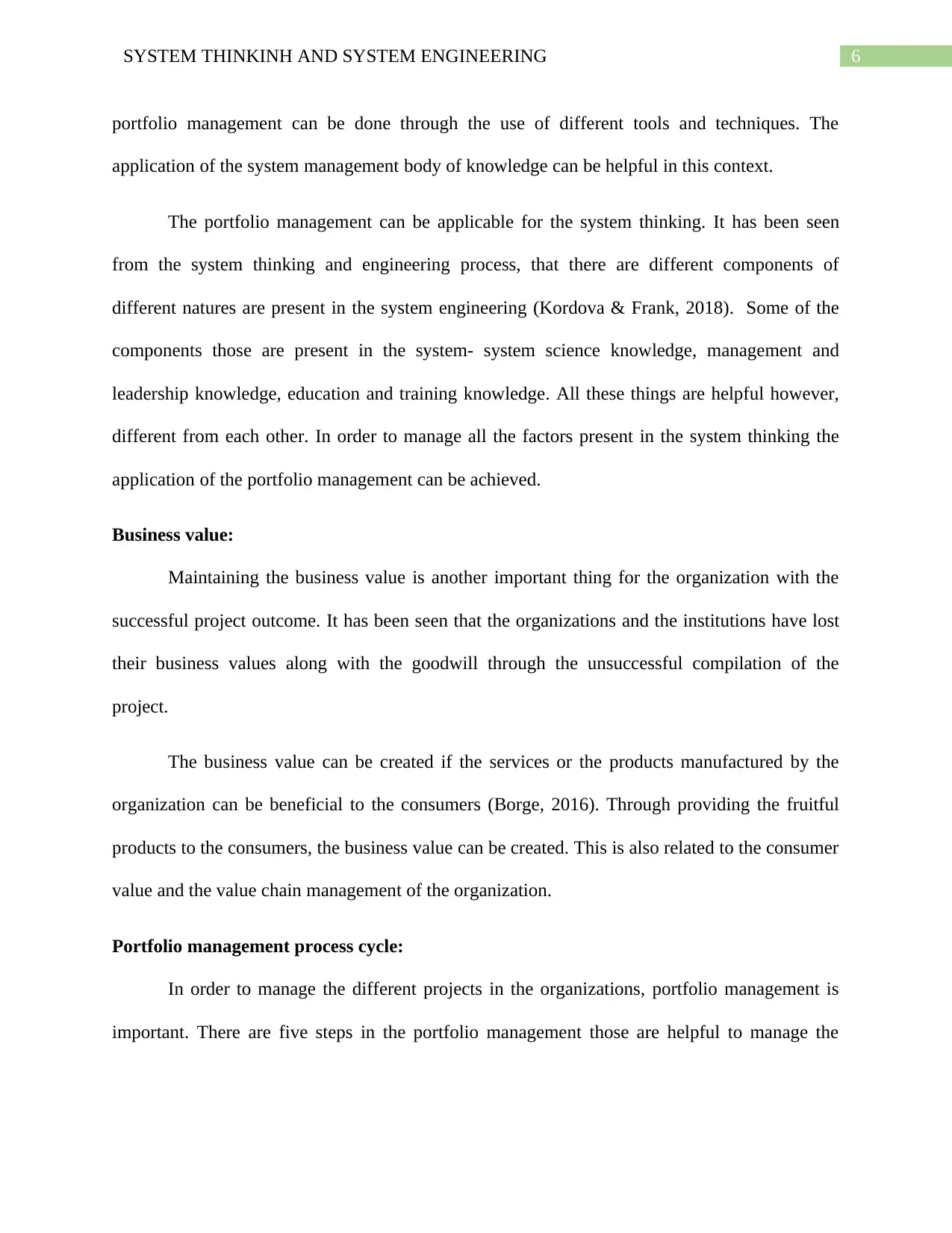
6SYSTEM THINKINH AND SYSTEM ENGINEERING
portfolio management can be done through the use of different tools and techniques. The
application of the system management body of knowledge can be helpful in this context.
The portfolio management can be applicable for the system thinking. It has been seen
from the system thinking and engineering process, that there are different components of
different natures are present in the system engineering (Kordova & Frank, 2018). Some of the
components those are present in the system- system science knowledge, management and
leadership knowledge, education and training knowledge. All these things are helpful however,
different from each other. In order to manage all the factors present in the system thinking the
application of the portfolio management can be achieved.
Business value:
Maintaining the business value is another important thing for the organization with the
successful project outcome. It has been seen that the organizations and the institutions have lost
their business values along with the goodwill through the unsuccessful compilation of the
project.
The business value can be created if the services or the products manufactured by the
organization can be beneficial to the consumers (Borge, 2016). Through providing the fruitful
products to the consumers, the business value can be created. This is also related to the consumer
value and the value chain management of the organization.
Portfolio management process cycle:
In order to manage the different projects in the organizations, portfolio management is
important. There are five steps in the portfolio management those are helpful to manage the
portfolio management can be done through the use of different tools and techniques. The
application of the system management body of knowledge can be helpful in this context.
The portfolio management can be applicable for the system thinking. It has been seen
from the system thinking and engineering process, that there are different components of
different natures are present in the system engineering (Kordova & Frank, 2018). Some of the
components those are present in the system- system science knowledge, management and
leadership knowledge, education and training knowledge. All these things are helpful however,
different from each other. In order to manage all the factors present in the system thinking the
application of the portfolio management can be achieved.
Business value:
Maintaining the business value is another important thing for the organization with the
successful project outcome. It has been seen that the organizations and the institutions have lost
their business values along with the goodwill through the unsuccessful compilation of the
project.
The business value can be created if the services or the products manufactured by the
organization can be beneficial to the consumers (Borge, 2016). Through providing the fruitful
products to the consumers, the business value can be created. This is also related to the consumer
value and the value chain management of the organization.
Portfolio management process cycle:
In order to manage the different projects in the organizations, portfolio management is
important. There are five steps in the portfolio management those are helpful to manage the
Paraphrase This Document
Need a fresh take? Get an instant paraphrase of this document with our AI Paraphraser
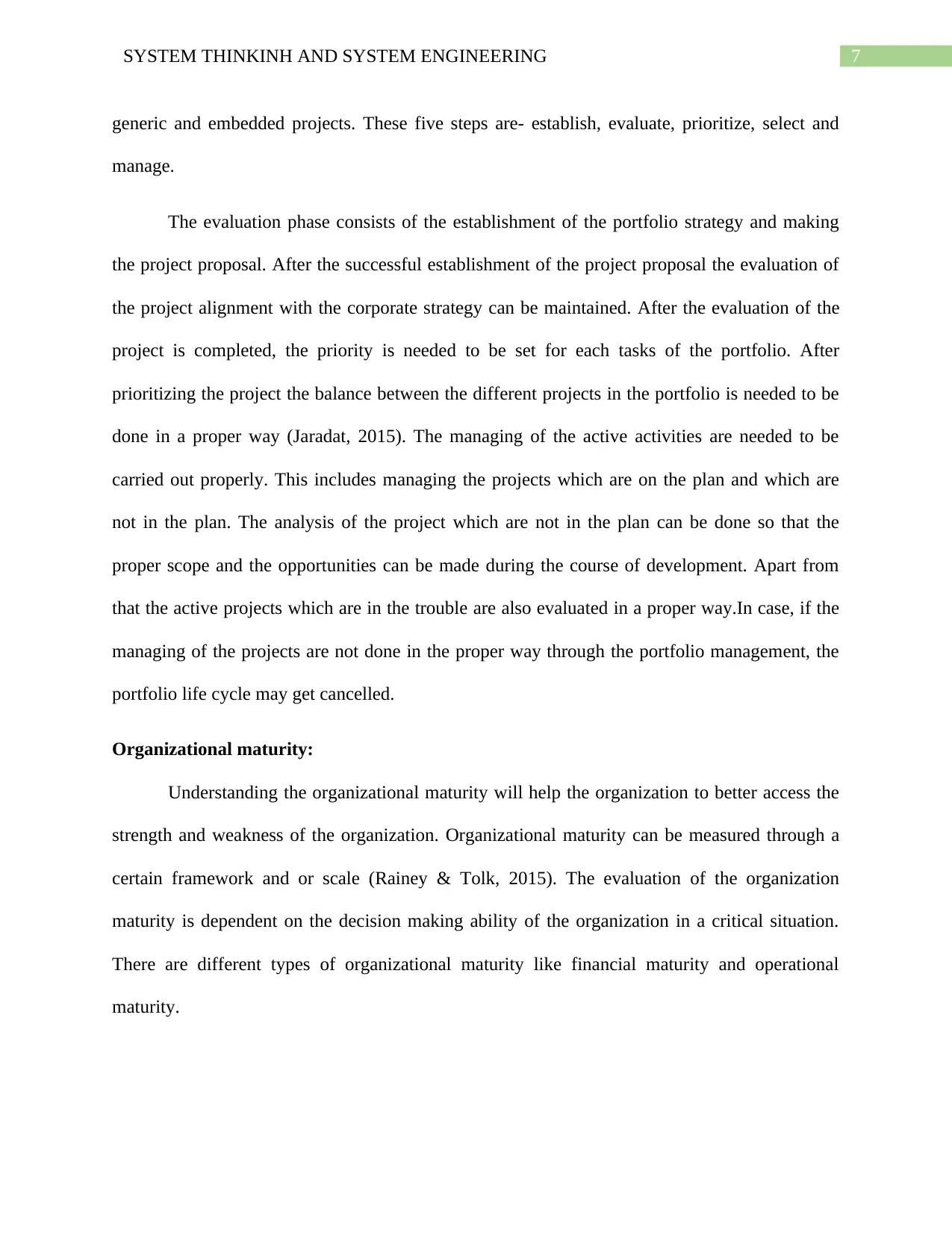
7SYSTEM THINKINH AND SYSTEM ENGINEERING
generic and embedded projects. These five steps are- establish, evaluate, prioritize, select and
manage.
The evaluation phase consists of the establishment of the portfolio strategy and making
the project proposal. After the successful establishment of the project proposal the evaluation of
the project alignment with the corporate strategy can be maintained. After the evaluation of the
project is completed, the priority is needed to be set for each tasks of the portfolio. After
prioritizing the project the balance between the different projects in the portfolio is needed to be
done in a proper way (Jaradat, 2015). The managing of the active activities are needed to be
carried out properly. This includes managing the projects which are on the plan and which are
not in the plan. The analysis of the project which are not in the plan can be done so that the
proper scope and the opportunities can be made during the course of development. Apart from
that the active projects which are in the trouble are also evaluated in a proper way.In case, if the
managing of the projects are not done in the proper way through the portfolio management, the
portfolio life cycle may get cancelled.
Organizational maturity:
Understanding the organizational maturity will help the organization to better access the
strength and weakness of the organization. Organizational maturity can be measured through a
certain framework and or scale (Rainey & Tolk, 2015). The evaluation of the organization
maturity is dependent on the decision making ability of the organization in a critical situation.
There are different types of organizational maturity like financial maturity and operational
maturity.
generic and embedded projects. These five steps are- establish, evaluate, prioritize, select and
manage.
The evaluation phase consists of the establishment of the portfolio strategy and making
the project proposal. After the successful establishment of the project proposal the evaluation of
the project alignment with the corporate strategy can be maintained. After the evaluation of the
project is completed, the priority is needed to be set for each tasks of the portfolio. After
prioritizing the project the balance between the different projects in the portfolio is needed to be
done in a proper way (Jaradat, 2015). The managing of the active activities are needed to be
carried out properly. This includes managing the projects which are on the plan and which are
not in the plan. The analysis of the project which are not in the plan can be done so that the
proper scope and the opportunities can be made during the course of development. Apart from
that the active projects which are in the trouble are also evaluated in a proper way.In case, if the
managing of the projects are not done in the proper way through the portfolio management, the
portfolio life cycle may get cancelled.
Organizational maturity:
Understanding the organizational maturity will help the organization to better access the
strength and weakness of the organization. Organizational maturity can be measured through a
certain framework and or scale (Rainey & Tolk, 2015). The evaluation of the organization
maturity is dependent on the decision making ability of the organization in a critical situation.
There are different types of organizational maturity like financial maturity and operational
maturity.
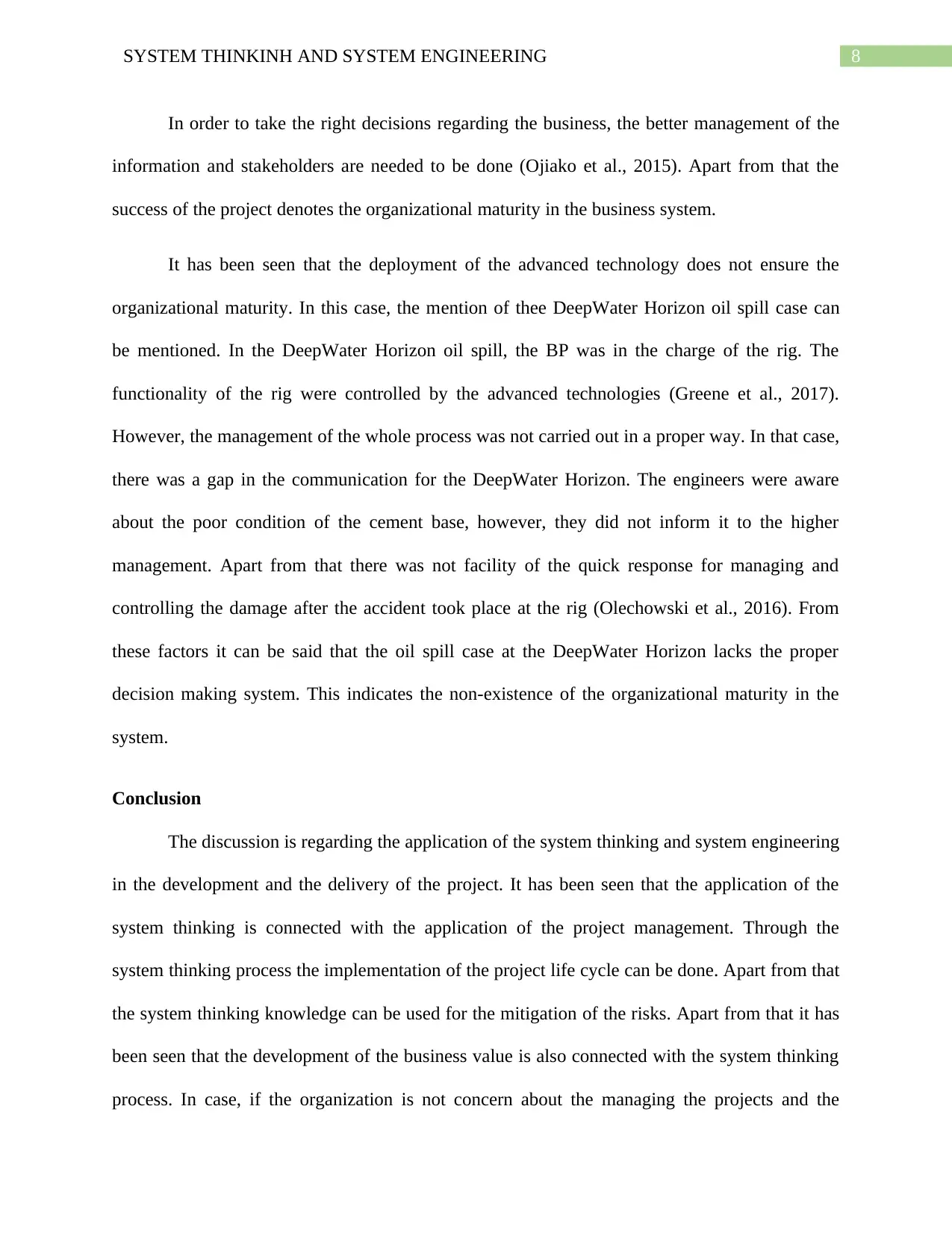
8SYSTEM THINKINH AND SYSTEM ENGINEERING
In order to take the right decisions regarding the business, the better management of the
information and stakeholders are needed to be done (Ojiako et al., 2015). Apart from that the
success of the project denotes the organizational maturity in the business system.
It has been seen that the deployment of the advanced technology does not ensure the
organizational maturity. In this case, the mention of thee DeepWater Horizon oil spill case can
be mentioned. In the DeepWater Horizon oil spill, the BP was in the charge of the rig. The
functionality of the rig were controlled by the advanced technologies (Greene et al., 2017).
However, the management of the whole process was not carried out in a proper way. In that case,
there was a gap in the communication for the DeepWater Horizon. The engineers were aware
about the poor condition of the cement base, however, they did not inform it to the higher
management. Apart from that there was not facility of the quick response for managing and
controlling the damage after the accident took place at the rig (Olechowski et al., 2016). From
these factors it can be said that the oil spill case at the DeepWater Horizon lacks the proper
decision making system. This indicates the non-existence of the organizational maturity in the
system.
Conclusion
The discussion is regarding the application of the system thinking and system engineering
in the development and the delivery of the project. It has been seen that the application of the
system thinking is connected with the application of the project management. Through the
system thinking process the implementation of the project life cycle can be done. Apart from that
the system thinking knowledge can be used for the mitigation of the risks. Apart from that it has
been seen that the development of the business value is also connected with the system thinking
process. In case, if the organization is not concern about the managing the projects and the
In order to take the right decisions regarding the business, the better management of the
information and stakeholders are needed to be done (Ojiako et al., 2015). Apart from that the
success of the project denotes the organizational maturity in the business system.
It has been seen that the deployment of the advanced technology does not ensure the
organizational maturity. In this case, the mention of thee DeepWater Horizon oil spill case can
be mentioned. In the DeepWater Horizon oil spill, the BP was in the charge of the rig. The
functionality of the rig were controlled by the advanced technologies (Greene et al., 2017).
However, the management of the whole process was not carried out in a proper way. In that case,
there was a gap in the communication for the DeepWater Horizon. The engineers were aware
about the poor condition of the cement base, however, they did not inform it to the higher
management. Apart from that there was not facility of the quick response for managing and
controlling the damage after the accident took place at the rig (Olechowski et al., 2016). From
these factors it can be said that the oil spill case at the DeepWater Horizon lacks the proper
decision making system. This indicates the non-existence of the organizational maturity in the
system.
Conclusion
The discussion is regarding the application of the system thinking and system engineering
in the development and the delivery of the project. It has been seen that the application of the
system thinking is connected with the application of the project management. Through the
system thinking process the implementation of the project life cycle can be done. Apart from that
the system thinking knowledge can be used for the mitigation of the risks. Apart from that it has
been seen that the development of the business value is also connected with the system thinking
process. In case, if the organization is not concern about the managing the projects and the
⊘ This is a preview!⊘
Do you want full access?
Subscribe today to unlock all pages.

Trusted by 1+ million students worldwide
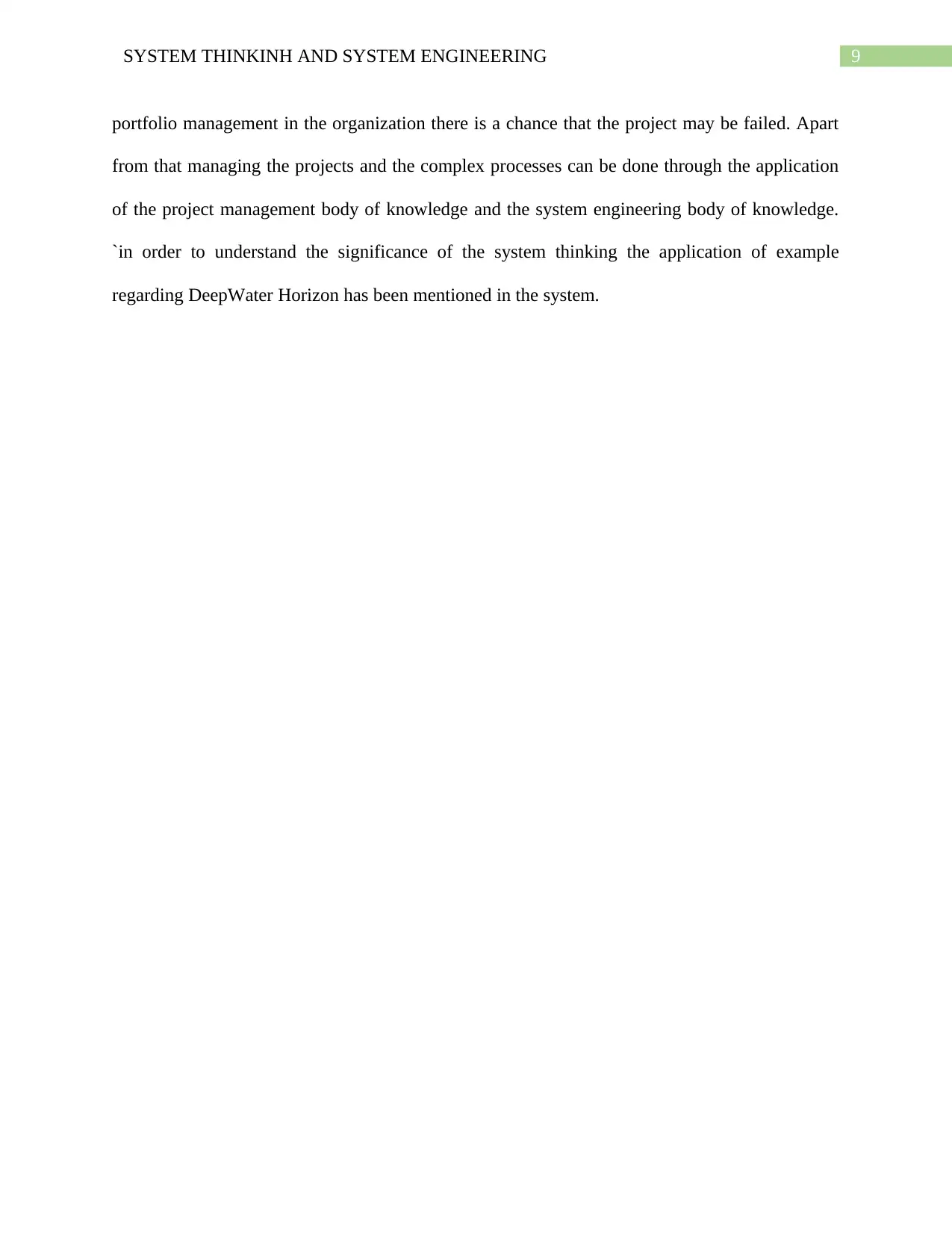
9SYSTEM THINKINH AND SYSTEM ENGINEERING
portfolio management in the organization there is a chance that the project may be failed. Apart
from that managing the projects and the complex processes can be done through the application
of the project management body of knowledge and the system engineering body of knowledge.
`in order to understand the significance of the system thinking the application of example
regarding DeepWater Horizon has been mentioned in the system.
portfolio management in the organization there is a chance that the project may be failed. Apart
from that managing the projects and the complex processes can be done through the application
of the project management body of knowledge and the system engineering body of knowledge.
`in order to understand the significance of the system thinking the application of example
regarding DeepWater Horizon has been mentioned in the system.
Paraphrase This Document
Need a fresh take? Get an instant paraphrase of this document with our AI Paraphraser
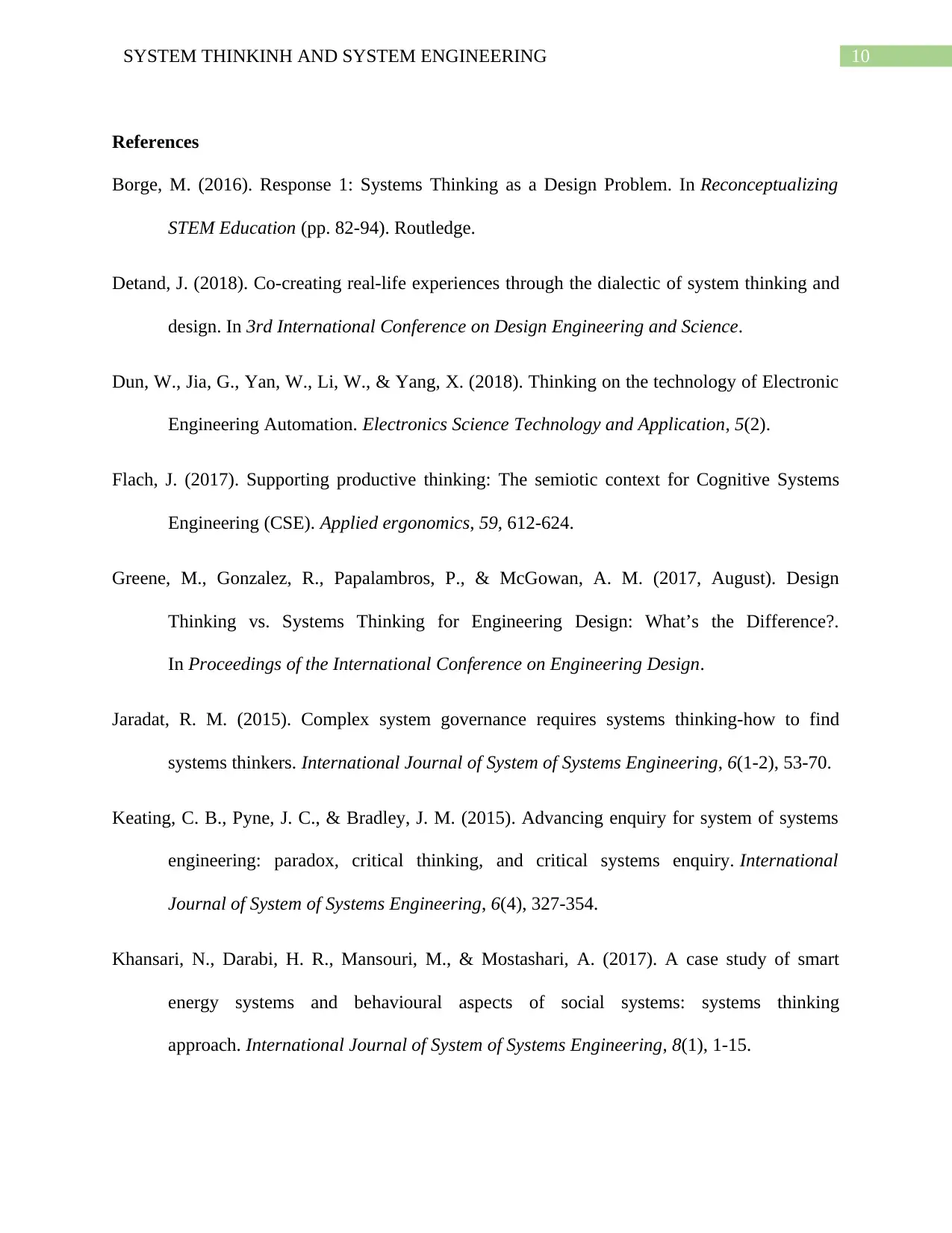
10SYSTEM THINKINH AND SYSTEM ENGINEERING
References
Borge, M. (2016). Response 1: Systems Thinking as a Design Problem. In Reconceptualizing
STEM Education (pp. 82-94). Routledge.
Detand, J. (2018). Co-creating real-life experiences through the dialectic of system thinking and
design. In 3rd International Conference on Design Engineering and Science.
Dun, W., Jia, G., Yan, W., Li, W., & Yang, X. (2018). Thinking on the technology of Electronic
Engineering Automation. Electronics Science Technology and Application, 5(2).
Flach, J. (2017). Supporting productive thinking: The semiotic context for Cognitive Systems
Engineering (CSE). Applied ergonomics, 59, 612-624.
Greene, M., Gonzalez, R., Papalambros, P., & McGowan, A. M. (2017, August). Design
Thinking vs. Systems Thinking for Engineering Design: What’s the Difference?.
In Proceedings of the International Conference on Engineering Design.
Jaradat, R. M. (2015). Complex system governance requires systems thinking-how to find
systems thinkers. International Journal of System of Systems Engineering, 6(1-2), 53-70.
Keating, C. B., Pyne, J. C., & Bradley, J. M. (2015). Advancing enquiry for system of systems
engineering: paradox, critical thinking, and critical systems enquiry. International
Journal of System of Systems Engineering, 6(4), 327-354.
Khansari, N., Darabi, H. R., Mansouri, M., & Mostashari, A. (2017). A case study of smart
energy systems and behavioural aspects of social systems: systems thinking
approach. International Journal of System of Systems Engineering, 8(1), 1-15.
References
Borge, M. (2016). Response 1: Systems Thinking as a Design Problem. In Reconceptualizing
STEM Education (pp. 82-94). Routledge.
Detand, J. (2018). Co-creating real-life experiences through the dialectic of system thinking and
design. In 3rd International Conference on Design Engineering and Science.
Dun, W., Jia, G., Yan, W., Li, W., & Yang, X. (2018). Thinking on the technology of Electronic
Engineering Automation. Electronics Science Technology and Application, 5(2).
Flach, J. (2017). Supporting productive thinking: The semiotic context for Cognitive Systems
Engineering (CSE). Applied ergonomics, 59, 612-624.
Greene, M., Gonzalez, R., Papalambros, P., & McGowan, A. M. (2017, August). Design
Thinking vs. Systems Thinking for Engineering Design: What’s the Difference?.
In Proceedings of the International Conference on Engineering Design.
Jaradat, R. M. (2015). Complex system governance requires systems thinking-how to find
systems thinkers. International Journal of System of Systems Engineering, 6(1-2), 53-70.
Keating, C. B., Pyne, J. C., & Bradley, J. M. (2015). Advancing enquiry for system of systems
engineering: paradox, critical thinking, and critical systems enquiry. International
Journal of System of Systems Engineering, 6(4), 327-354.
Khansari, N., Darabi, H. R., Mansouri, M., & Mostashari, A. (2017). A case study of smart
energy systems and behavioural aspects of social systems: systems thinking
approach. International Journal of System of Systems Engineering, 8(1), 1-15.
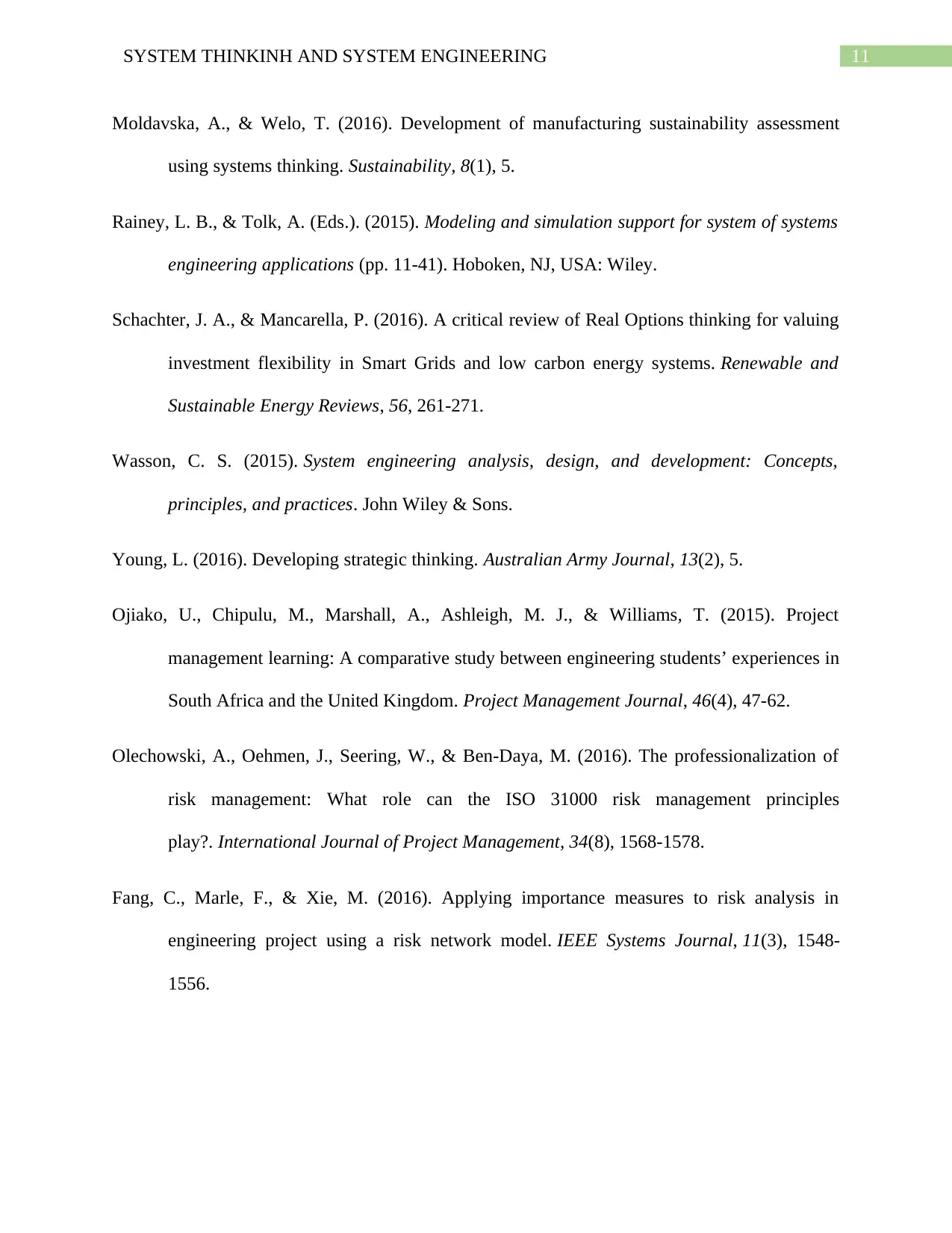
11SYSTEM THINKINH AND SYSTEM ENGINEERING
Moldavska, A., & Welo, T. (2016). Development of manufacturing sustainability assessment
using systems thinking. Sustainability, 8(1), 5.
Rainey, L. B., & Tolk, A. (Eds.). (2015). Modeling and simulation support for system of systems
engineering applications (pp. 11-41). Hoboken, NJ, USA: Wiley.
Schachter, J. A., & Mancarella, P. (2016). A critical review of Real Options thinking for valuing
investment flexibility in Smart Grids and low carbon energy systems. Renewable and
Sustainable Energy Reviews, 56, 261-271.
Wasson, C. S. (2015). System engineering analysis, design, and development: Concepts,
principles, and practices. John Wiley & Sons.
Young, L. (2016). Developing strategic thinking. Australian Army Journal, 13(2), 5.
Ojiako, U., Chipulu, M., Marshall, A., Ashleigh, M. J., & Williams, T. (2015). Project
management learning: A comparative study between engineering students’ experiences in
South Africa and the United Kingdom. Project Management Journal, 46(4), 47-62.
Olechowski, A., Oehmen, J., Seering, W., & Ben-Daya, M. (2016). The professionalization of
risk management: What role can the ISO 31000 risk management principles
play?. International Journal of Project Management, 34(8), 1568-1578.
Fang, C., Marle, F., & Xie, M. (2016). Applying importance measures to risk analysis in
engineering project using a risk network model. IEEE Systems Journal, 11(3), 1548-
1556.
Moldavska, A., & Welo, T. (2016). Development of manufacturing sustainability assessment
using systems thinking. Sustainability, 8(1), 5.
Rainey, L. B., & Tolk, A. (Eds.). (2015). Modeling and simulation support for system of systems
engineering applications (pp. 11-41). Hoboken, NJ, USA: Wiley.
Schachter, J. A., & Mancarella, P. (2016). A critical review of Real Options thinking for valuing
investment flexibility in Smart Grids and low carbon energy systems. Renewable and
Sustainable Energy Reviews, 56, 261-271.
Wasson, C. S. (2015). System engineering analysis, design, and development: Concepts,
principles, and practices. John Wiley & Sons.
Young, L. (2016). Developing strategic thinking. Australian Army Journal, 13(2), 5.
Ojiako, U., Chipulu, M., Marshall, A., Ashleigh, M. J., & Williams, T. (2015). Project
management learning: A comparative study between engineering students’ experiences in
South Africa and the United Kingdom. Project Management Journal, 46(4), 47-62.
Olechowski, A., Oehmen, J., Seering, W., & Ben-Daya, M. (2016). The professionalization of
risk management: What role can the ISO 31000 risk management principles
play?. International Journal of Project Management, 34(8), 1568-1578.
Fang, C., Marle, F., & Xie, M. (2016). Applying importance measures to risk analysis in
engineering project using a risk network model. IEEE Systems Journal, 11(3), 1548-
1556.
⊘ This is a preview!⊘
Do you want full access?
Subscribe today to unlock all pages.

Trusted by 1+ million students worldwide
1 out of 14
Related Documents
Your All-in-One AI-Powered Toolkit for Academic Success.
+13062052269
info@desklib.com
Available 24*7 on WhatsApp / Email
![[object Object]](/_next/static/media/star-bottom.7253800d.svg)
Unlock your academic potential
Copyright © 2020–2025 A2Z Services. All Rights Reserved. Developed and managed by ZUCOL.





